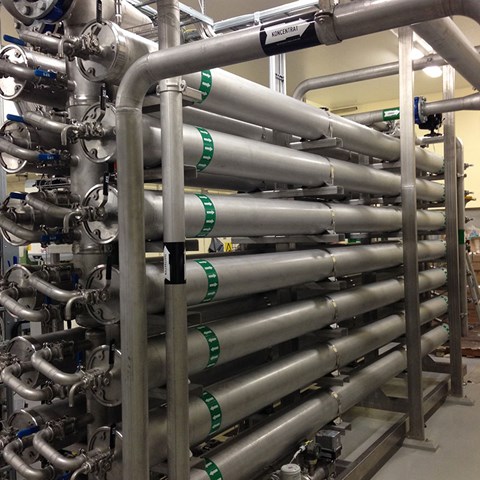Contact
SLU Water forum
water@slu.se, +46 (0)10-478 41 44

Most countries face major challenges when it comes to their future drinking water supply. There are increased risks of chemical pollution because of high levels of chemical use in society, climate change (droughts and floods) and an intensive urbanization that in many cases threatens sensitive water protection areas. To develop relevant policies and take adequate action, scientifically founded knowledge and strategic collaboration between science and policy is crucial.
The case of PFASs (per- and polyfluoroalkyl substances) in Swedish waters is an illustrative example where research increased awareness, generated development of remediation and treatment technologies, and contributed to new national drinking water and groundwater guidelines. PFASs have received global public attention due to their persistence, bioaccumulation potential and possible adverse effects on organisms (Ahrens and Bundschuh 2014). Recently, several Swedish water sources had to be restricted or even shut down because residues of PFASs had reached the groundwater and contaminated wells (e.g. in Uppsala and Ronneby). Swedish University of Agricultural Sciences (SLU) and Swedish Environmental Research Institute (IVL) researchers discovered that the fire training facility at Stockholm Arlanda Airport is an important source of PFASs to the nearby environment due to the usage of PFAS-containing aqueous fire-fighting foams (Ahrens et al., 2015). PFASs are transported from the contaminated area at the airport through watercourses towards Lake Mälaren. The contamination of the lake is of concern since it is the largest drinking water reservoir in Sweden (used by ~2 million people in the Stockholm area). However, remediation and treatment techniques for PFAS-contaminated soil and water have been lacking. Researchers at SLU have reported that phytoremediation is not just a passive, low cost, and low maintenance remediation technique, it also remains the least expensive option in large scale applications for PFAS contaminated sites (Gobelius et al. 2017). Conventional drinking water treatment plants are inefficient for the removal of PFASs in drinking water, and various treatment techniques for drinking water, such as activated carbon and anion exchange have been evaluated (McCleaf et al., 2017; Kothawala et al., 2017) and reviewed (Franke et al., 2018) by SLU researchers. The results indicate the selective nature of PFAS removal as the absorbents are loaded with PFASs and dissolved organic carbon (DOC). Furthermore, the operators of the drinking water treatment plants have to account for relatively short bed volumes runs for short-chained PFASs. Advanced treatment technologies are piloted by the researchers in collaboration with local water utilities (e.g. Uppsala Vatten, Norrvatten, Stockholm Vatten). With the new knowledge, the Swedish National Food Agency issued a recommendation for PFASs in drinking water (i.e. that the sum of 11 PFASs should be below 90 ng/L (Gobelius et al., 2018)). Additionally, in 2015 Sweden was one of the first countries implementing a guideline value for perfluorooctane sulfonate (PFOS) in groundwater. This has furthermore generated monitoring campaigns for PFASs in the aquatic environment (Gobelius et al., 2018; Nguyen et al., 2017), to increase the knowledge on sources and risks from PFASs in the aquatic environment.
There is a great need for sensitive analytical methods to detect new chemical threats at an early stage and for effective water treatment technologies. Parallel to national monitoring programs of pollution levels that enable early warnings of threats, preventive work is needed upstream to avoid pollution of ground and surface waters. This includes protection of water supply areas, tracing sources of pollution, assessing dissemination routes, as well as the climate impact on them. To further prepare for chemical risks to drinking water in Sweden, steps are currently taken to intensify the strategic collaboration between SLU and Uppsala University, with the national authorities Swedish National Food Agency and the Geology Survey of Sweden, and with local water utilities (e.g. Uppsala Vatten and Norrvatten). Strengthened partnerships are instrumental to deal with the complex challenges of chemical risks to drinking water.
Ahrens L, Bundschuh M, 2014. Fate and effects of poly- and perfluoroalkyl substances in the aquatic environment: A review. Environ Toxicol Chem, 33, 1921–1929.
Ahrens L, Norström K, Viktor T, Palm Cousins A, Josefsson S, 2015. Stockholm Arlanda Airport as a source of per- and polyfluoroalkyl substances to water, sediment and fish. Chemosphere 129, 33–38.
Franke V., McCleaf P., Wiberg K., Ahrens L. Removal of per- and polyfluoro alkyl substances (PFASs) in drinking water: review of treatment techniques and their practical application (Hur kan PFAS-ämnen avlägsnas i vattenverken? En granskning av nya och befintliga reningstekniker). Svenskt Vatten Utveckling, Report 2017-20, 2017.
Gobelius L, Lewis J, Ahrens L, 2017. Plant Uptake of Per- and Polyfluoroalkyl Substances at a Contaminated Fire Training Facility to Evaluate the Phytoremediation Potential of Various Plant Species. Environ. Sci. Technol. 51, 12602–12610.
Gobelius L., Hedlund J., Dürig W., Tröger R., Wiberg K., Lilja K., Ahrens L. Per- and polyfluoroalkyl substances in Swedish groundwater and surface water: Implications for Environmental Quality Standards and drinking water guidelines. Environmental Science & Technology, 52(7):4340-4349, 2018.
Kothawala DN, Köhler SJ, Östlund A, Wiberg K, Ahrens L, 2017. Influence of dissolved organic matter concentration and composition on the removal efficiency of perfluoroalkyl substances (PFASs) during drinking water treatment. Water Res. 121, 320–28.
McCleaf P, Englund S, Östlund A, Lindegren K, Wiberg K, Ahrens L, 2017. Removal efficiency of multiple poly-and perfluoroalkyl substances (PFASs) in drinking water using granular activated carbon (GAC) and anion exchange (AE) column tests. Water Res. 120, 77–87.
Nguyen M. A., Wiberg K., Ribeli E., Josefsson S., Futter M., Gustavsson J., Ahrens L. Spatial distribution and source tracing of per- and polyfluoroalkyl substances (PFASs) in surface water in Northern Europe. Environmental Pollution, 220:1438-1446, 2017.
SLU Water forum
water@slu.se, +46 (0)10-478 41 44